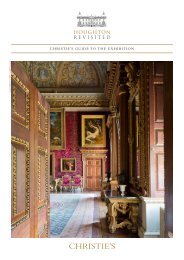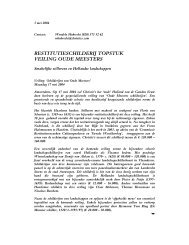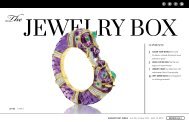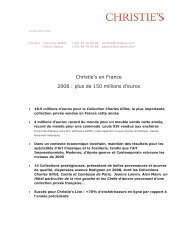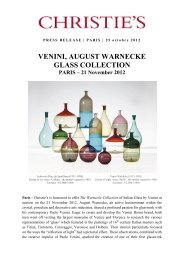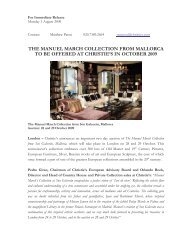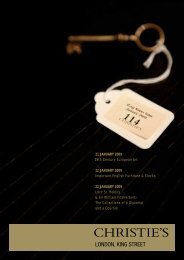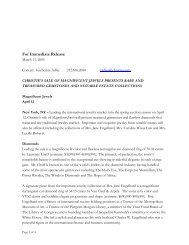Yves Saint Laurent Pierre Bergé - Christie's
Yves Saint Laurent Pierre Bergé - Christie's
Yves Saint Laurent Pierre Bergé - Christie's
You also want an ePaper? Increase the reach of your titles
YUMPU automatically turns print PDFs into web optimized ePapers that Google loves.
178<br />
The Kunstkammer<br />
Princely Reputation<br />
and Decoration<br />
Before the idea of displaying objects in a museumlike<br />
context, the only way to view treasures in<br />
courtly society north of the Alps was in the context<br />
of a Kunstkammer, literally translated as an ‘art<br />
cabinet’. In the 16th and 17th centuries wealthy<br />
members of the royal houses of modern day<br />
Austria and Germany feverishly collected, and<br />
commissioned artists to produce virtuoso works of<br />
art in exotic materials for their Kunstkammer. The<br />
purpose of these collections was for the fürstliche<br />
Reputation und Zier (princely reputation and<br />
decoration) as well as the intellectual understanding<br />
of the natural world. Through the carving and<br />
subsequent observation of wondrous natural<br />
elements such as cameos, hardstones, ivories,<br />
corals and minerals, examples of which can be<br />
seen throughout the <strong>Yves</strong> <strong>Saint</strong> <strong>Laurent</strong> and <strong>Pierre</strong><br />
<strong>Bergé</strong> collection, these collectors felt as if nature,<br />
and indeed the universe itself, could be categorised,<br />
shaped and indeed contained by mankind.<br />
Display of cameos, rue de Babylone<br />
At the time, the art of creating and displaying these<br />
items represented the pinnacle of mankind’s<br />
handling of nature, since the physical properties of<br />
many of these highly prized materials often meant<br />
that only the greatest craftsmen could work on them.<br />
This naturally resulted in the fact that only the<br />
greatest patrons could afford to acquire such works<br />
of art and thus used them as symbols of their great<br />
power, wealth and intellect. While many significant<br />
collections of Kunst- and Wunderkammern were<br />
formed from the late 16th century onwards, perhaps<br />
the most important were those of Louis XIV in<br />
Versailles, Augustus the Strong in Dresden and<br />
Rudolph II in Prague. Today, there are very few<br />
historic Kunstkammern still in existence. The diverse<br />
group of mounted cameos, rock crystal cups and<br />
carved ivory vessels in the <strong>Saint</strong> <strong>Laurent</strong> and <strong>Bergé</strong><br />
collection therefore offers not only a rare glimpse<br />
into a modern day Kunstkammer but an even rarer<br />
opportunity to possess one.




